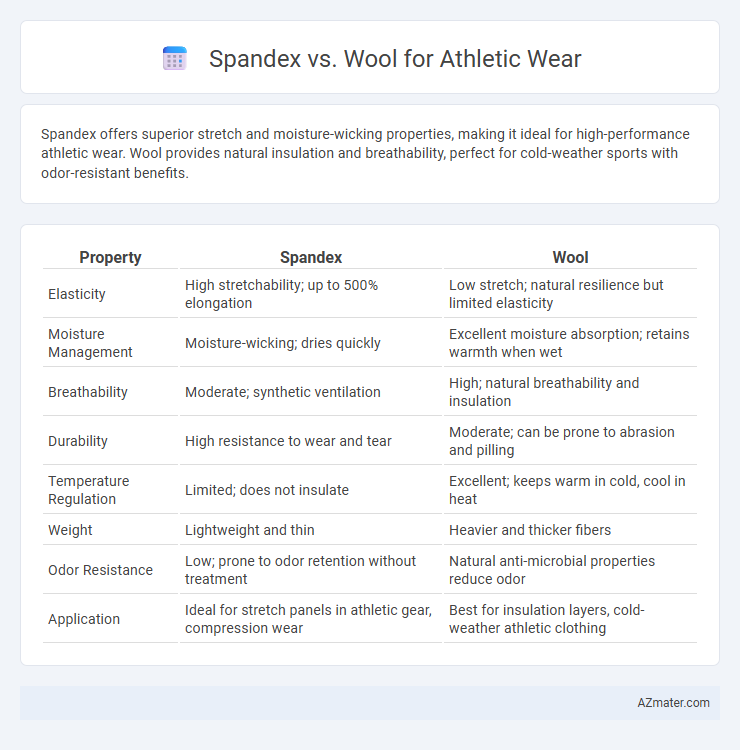Spandex offers superior stretch and moisture-wicking properties, making it ideal for high-performance athletic wear. Wool provides natural insulation and breathability, perfect for cold-weather sports with odor-resistant benefits.
Table of Comparison
| Property | Spandex | Wool |
|---|---|---|
| Elasticity | High stretchability; up to 500% elongation | Low stretch; natural resilience but limited elasticity |
| Moisture Management | Moisture-wicking; dries quickly | Excellent moisture absorption; retains warmth when wet |
| Breathability | Moderate; synthetic ventilation | High; natural breathability and insulation |
| Durability | High resistance to wear and tear | Moderate; can be prone to abrasion and pilling |
| Temperature Regulation | Limited; does not insulate | Excellent; keeps warm in cold, cool in heat |
| Weight | Lightweight and thin | Heavier and thicker fibers |
| Odor Resistance | Low; prone to odor retention without treatment | Natural anti-microbial properties reduce odor |
| Application | Ideal for stretch panels in athletic gear, compression wear | Best for insulation layers, cold-weather athletic clothing |
Introduction to Athletic Wear Fabrics
Spandex and wool serve distinct roles in athletic wear fabrics, each offering unique benefits tailored to performance needs. Spandex provides exceptional elasticity, moisture-wicking, and breathability, making it ideal for high-intensity workouts and sports requiring flexibility. Wool, particularly merino wool, excels in temperature regulation, odor resistance, and natural moisture management, suitable for outdoor activities in varying climates.
Key Properties of Spandex
Spandex is known for its exceptional elasticity, allowing athletic wear to stretch up to 500% while maintaining shape, which enhances mobility and comfort during intense physical activities. Its moisture-wicking capabilities ensure quick drying, reducing sweat accumulation and improving breathability compared to wool. Lightweight and resistant to abrasion, Spandex fabrics provide durability and a snug fit, making them ideal for performance-focused sportswear.
Key Properties of Wool
Wool offers excellent moisture-wicking properties, natural breathability, and superior thermal regulation, making it ideal for maintaining comfort during athletic activities. Its antimicrobial nature helps reduce odor buildup, while the fiber's elasticity provides a degree of stretch and durability. Wool's ability to insulate even when wet outperforms many synthetic materials, contributing to enhanced performance in variable weather conditions.
Moisture Management: Spandex vs Wool
Spandex offers superior moisture-wicking capabilities by quickly pulling sweat away from the skin, keeping athletes dry during intense workouts. Wool, particularly merino wool, excels in moisture management by absorbing up to 30% of its weight in moisture while maintaining breathability and regulating temperature. While spandex is ideal for rapid moisture evaporation, wool provides natural odor resistance and sustained comfort in varying conditions.
Breathability and Temperature Regulation
Spandex offers excellent breathability and moisture-wicking properties, making it ideal for athletic wear that requires temperature regulation during intense workouts. Wool provides natural insulation and breathes effectively, maintaining warmth while preventing overheating through its moisture-absorbing fibers. Athletes seeking optimal performance benefit from spandex's stretch and cooling abilities, while wool suits those needing superior temperature control in variable weather conditions.
Comfort and Fit Comparison
Spandex offers superior stretch and flexibility, providing a snug, second-skin fit that moves with the body during high-intensity athletic activities. Wool, particularly merino wool, excels in breathability and moisture-wicking, maintaining comfort by regulating temperature and reducing odor despite limited elasticity. While spandex maximizes range of motion, wool delivers natural insulation and softness, making the choice dependent on the specific athletic needs for comfort and fit.
Durability and Longevity
Spandex offers superior elasticity and retains its shape over time, making it highly durable for intense athletic activities and frequent washing. Wool provides natural breathability and odor resistance but may wear down faster when subjected to constant abrasion and moisture. For longevity, spandex blends are often favored in athletic wear due to their resilience and ability to withstand rigorous use without significant deterioration.
Odor Resistance and Hygiene
Wool offers superior odor resistance and natural antimicrobial properties, making it ideal for athletic wear that requires prolonged use without frequent washing. Spandex, while stretchy and form-fitting, lacks inherent odor control and can retain sweat, leading to quicker buildup of bacteria and unpleasant smells. Athletes aiming for hygiene and freshness during intense workouts often prefer wool blends combined with spandex for balanced performance and odor management.
Environmental Impact: Spandex vs Wool
Spandex production relies heavily on non-renewable petroleum-based resources and releases greenhouse gases during manufacturing, contributing significantly to environmental pollution. Wool is a renewable natural fiber obtained from sheep, but its environmental impact includes methane emissions from livestock and land use concerns. Choosing wool over spandex for athletic wear can reduce reliance on synthetic polymers, although sustainable wool practices are essential to minimize ecological footprints.
Best Uses and Recommendations for Athletes
Spandex excels in athletic wear due to its superior elasticity, moisture-wicking properties, and durability, making it ideal for high-intensity activities like running, cycling, and yoga. Wool offers excellent temperature regulation, natural odor resistance, and breathability, which suits endurance sports, outdoor workouts, and cooler weather conditions. Athletes seeking flexibility and sweat management should prioritize spandex blends, while those competing in varied climates or needing natural insulation benefit from wool-based fabrics.

Infographic: Spandex vs Wool for Athletic Wear
 azmater.com
azmater.com